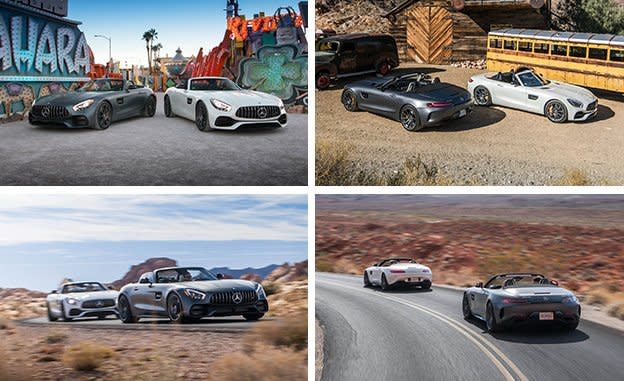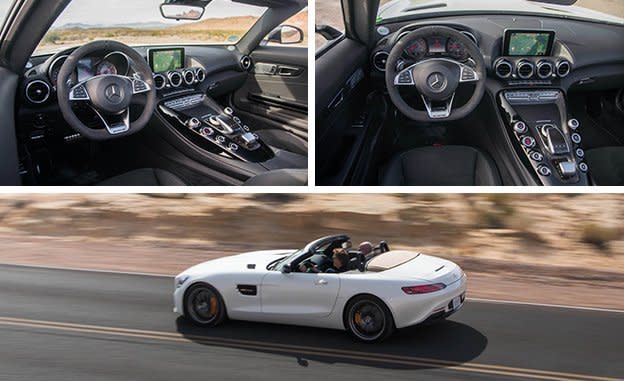2018 Mercedes-AMG GT / GT C Roadster

AMG chairman Tobias Moers is pushing his brand’s pedal to the floor. Two years after unveiling the spectacular Mercedes-AMG GT coupe, Daimler’s high-performance sub-brand displayed a droptop derivative in September, and now we’ve been invited to ride along with Moers in prototypes undergoing testing late in the development process.
Where else to exercise the GT roadster than in and around Las Vegas? Sin City is a perfect place to sample the GT roadster: The city embodies money and glitz, and the surrounding landscape of otherworldy terrain and deep canyons is lined with many wide-open—and lightly patrolled—highways.

Both a standard GT roadster and a more powerful GT C roadster were on hand, the cars being en route from the West Coast to proving grounds near Phoenix, Arizona. Is AMG not testing in Death Valley? “Not anymore,” says Moers, noting that his team made its last trip there in 2015. “We can test everything in Arizona,” he says. And Arizona allows for more easily reproduced conditions and nearly as much heat—but at a private facility where there are no interruptions from police, nosy tourists with smartphones, or prowling spy photographers.
Here are the details of the two models we rode in: The base GT roadster makes 469 horsepower, the GT C roadster 550 horsepower. There also will be a GT S roadster packing 503 horsepower. An open-topped version of the hard-core GT R model is possible, but we couldn’t get Moers to spill those beans.
Foreshadowing a facelift that will migrate to the GT coupe, both roadsters sport the new “Rennsport” grille, inspired by the 1952 300SL Panamericana and first seen on the GT R coupe. Expect to see the theme also filter to AMG variations of more mainstream Mercedes production cars. Visually, the clearest difference between the base and C GTs can be seen from the rear—the C features vertical air outlets left and right, plus a horizontal slit between the taillights. It looks impressive, and it underscores the ties to the GT R.

Not only is the GT C variant more powerful than the standard GT, but it has a wider track, its body is widened by 2.2 inches, and there are several chassis modifications. The adaptive dampers are standard, and the tires grow from 255/35R-19 up front and 295/35R-19 in the rear to 265/35R-19 front and 305/30R-20 abaft. The GT C’s front brakes are larger, there is a four-wheel-steering system, and the transmission gains an additional, more aggressive mode labeled Race.
Inside, the GT roadster looks exactly like the coupe, with one difference: The ceiling-mounted array of buttons that lend the coupe a jet-fighter ambience have moved to the center console. But otherwise, the cabin is unchanged. The top can be lowered or raised while the car is moving, and it maintains a tight seal up to top speed, which nudges the 200-mph threshold, according to Mercedes.
Only an expert at the wheel would notice the differences between the GT and the GT C roadster. Thankfully, Tobias Moers is one, and probably the most qualified of all. He has been with AMG since 1994, and the GT—a spiritual descendent of the gullwinged SLS, the instant classic that already fetches incredible money—is his baby.

But even from the passenger seat—remember, we weren’t allowed to get behind the wheel—one can tell that these roadsters exhibit their very own character. The soundtrack is nearly overwhelming, with the fantastically aggressive exhaust note almost totally drowning out the mechanical sounds of the direct-injected 4.0-liter twin-turbo V-8. There’s a bellow when the throttle blips on downshifts and a crackle when you let off the gas. Of course, the aural sensation is amplified when the top is lowered, one of the roadster’s great advantages over the coupe.
And that sweet noise is backed up with substance. Maximum torque is delivered on a plateau that begins at well below 2000 rpm, while the swell of horsepower peaks beyond 6000 rpm. It’ll pin you into the seat like few other cars on the road.
From our perch, the braking system scrubbed speed quickly and decisively. And lateral loading indicates that the chassis is supremely capable. Moers makes few adjustments as he winds and unwinds the wheel, and the car’s responses to his inputs show the steering seems to be as direct as the coupe’s. It’s perhaps a bit darty, but grip levels are extremely high, and experts can steer the GT roadster with their right foot.

A final thing we noticed: The GT roadster prototypes already feel of a piece. There are no squeaks and rattles even on these preproduction units, and the structure feels quite rigid, no doubt in part due to the cross-shaped carbon-fiber underbody brace that’s standard not only here but on the GT R, too. The weight penalty is almost negligible—despite the addition of the stiffening measures and the power-folding softtop and its mechanicals, we are told the open-roofed cars are barely 120 pounds heavier.
On this development drive, Moers is checking the functions, the integration, and the overall harmony of the vehicle. Come spring, the press will get to drive production models, and the first customers will take delivery before summer. There is a little time left to tweak details, but not much.
On these prototypes, the trunklids don’t fit well, and the steering hasn’t been calibrated for series production. Moers says he has noticed a few more issues “that I won’t tell you about.”
That’s okay. With the boss on top of it, those will be addressed before the time the GT roadster reaches showrooms. Then, it will chase the open-top competition from Aston Martin, Audi, Jaguar, and Maserati. But, most of all, this AMG targets the cabriolet editions of the Porsche 911 and 911 Turbo. We’ll have to wait to see how it stacks up. What we can tell you is that the GT roadster already feels like a strong contender to grab its fair share of the action in Las Vegas and beyond.

 Yahoo Autos
Yahoo Autos 